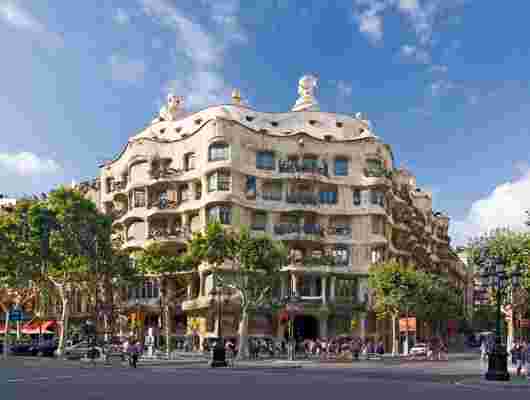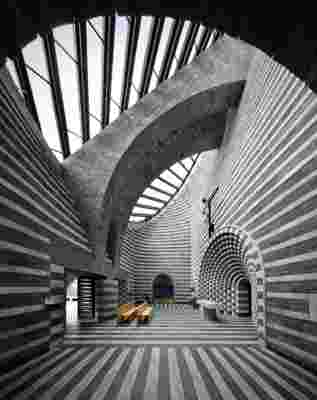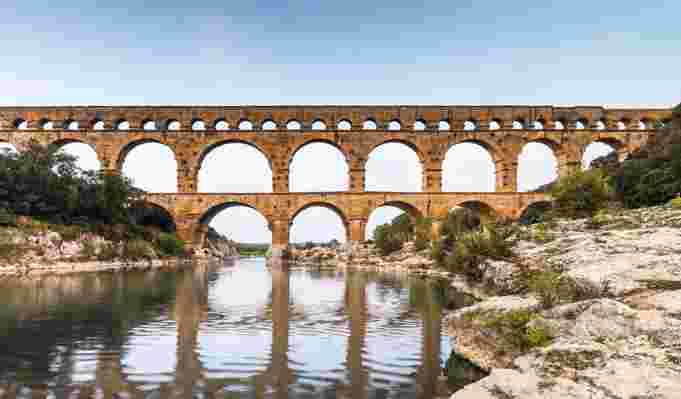Stone is one of the world's oldest building materials, appreciated for its strength and durability. In ancient times it was chosen for its abundance: As a natural material, it was readily available and dependable. But there's a lot more to the material than one might expect, and there's a reason why architects continue to build with it, around it, and in it. The structures on this list demonstrate stone's ability to shape-shift; it can be used in its raw form or polished for a sleeker effect. It's no wonder that it's the chosen material for important monuments and buildings such as places of worship, castles , and palaces, as it will outlast almost any other material.

The last house that Gaudí ever designed, the structure earned the nickname La Pedrera (the Stone Quarry) for its unique limestone façade.

In 1986 an avalanche destroyed a 17th-century church, which Mario Botta replaced with his stunning design. White marble and dark gneiss give the tiny church an uplifting feel, and light floods in from above.

The tallest Roman aqueduct in the world, the Pont du Gard was used to bring fresh spring water to the area. The stones are impeccably cut with precision, and no mortar was used to keep it upright.
Due to the large number of high-rises in Riyadh, the roof of the King Abdullah Financial District Grand Mosque was an important consideration in the design.
What is left of a 12th-century monastery and a brewery were combined to create the Susch museum in Switzerland. Seeing as the two structures are protected, the architects took great strides to preserve them, though 9,000 tons of rock were excavated in order to provide more exhibition space.
The stone wall that surrounds the steel and glass structure provides shade and shelter inside the bus stop. The abstract forms are a nod to the region's topography.
According to Snøhetta, the building's low-lying form is intended to be landscape as much as it is architecture. The plaza is made of bush-hammered white Carrara marble
This subterranean space is partially submerged, which makes it low-energy and challenges traditional mosque design.
The building's design is inspired by the medieval street plan of Santiago, Spain, and evokes imagery of rolling hills, making it blend into the surrounding landscape.
Cut from volcanic tuff in the earth thirteenth century, this is the last of King Lalibela's rock-cut churches. The windows, floors, ceilings, and walls were all carved by hand.
The ultimate resource for design industry professionals, brought to you by the editors of Architectural Digest
This wondrous church was carved from chalky cliff somewhere around the seventeenth century, though some say it's much older. There are two churches that burrow deep into the ground, and a covered bell tower that links them.
Built in the tradition of the Japanese Non-church Movement, there aren't any religious artifacts like crosses or a transept. Instead, it is built with the idea of freedom of nature in mind, including an organic floor plan, foliage, rocks, a water channel, and ribbed skylights.
Combining Moorish, Arabian, and Mughal architecture, the Sheikh Zayed is the largest mosque in the United Arab Emirates. Its pure bright white marble exterior is matched with a warmer off-white marble interior, which holds the world's largest carpet.
Appropriately dubbed the 'House of the Rock,' this structure in Portugal makes use of the huge glacial rocks that litter the area. Walls were put up with a little bit of concrete to create a shelter.
As the home to a private collection of contemporary Latin American art, the Mexican travertine-clad structure breaks up the surrounding landscape with its arresting sawtooth roof.
Stone is available for from Phaidon .
